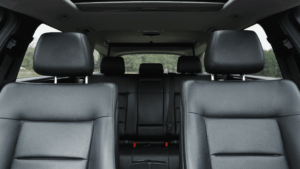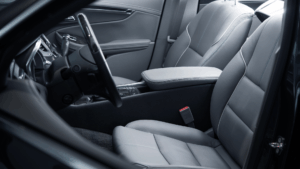When it comes to driving comfort, most people focus on the vehicle’s horsepower, air conditioning, or entertainment system. Yet, one of the most important parts of your car — and your long-term health — is something most drivers completely overlook: car seat ergonomics.
Your car seat plays a crucial role in supporting your posture, preventing fatigue, and protecting your spine during every journey. Whether you’re stuck in city traffic or driving across the island, how your seat is designed — and how you use it — can make the difference between a comfortable ride and lingering back pain.
In this guide, we’ll explore what good car seat ergonomics really mean, what features to look out for, and how small adjustments can protect your posture and overall spinal health.
Why car seat ergonomics matter more than you think
Sitting behind the wheel may seem harmless, but prolonged driving is one of the most common causes of back and neck discomfort in Singapore. The reason? Most car seats are designed for general fit and aesthetics — not for spinal health.

When you spend hours driving, your spine experiences constant vibration, restricted movement, and static posture. This leads to increased pressure on the lower back, tension in the shoulders, and tightness in the hips. Over time, this can result in:
- Persistent lower back pain
- Neck stiffness and tension headaches
- Poor posture and muscle fatigue
- Reduced flexibility in the hips and spine
Proper car seat ergonomics are about achieving balance — ensuring your spine’s natural curves are supported and your joints aren’t strained while driving.
How poor car seat design affects your spine
1. Lumbar support
The natural S-shaped curve of your spine should be preserved even while seated. Many factory-installed seats lack sufficient lumbar support, forcing drivers to slump forward or round their lower backs. This flattens the lumbar curve, placing pressure on spinal discs and surrounding muscles.
2. Seat depth and tilt
If your car seat is too deep, it pushes the pelvis forward, leading to slouching and hip discomfort. If it’s too short, your thighs lose support, affecting circulation and causing numbness during long drives. The right car seat ergonomics allow your knees to bend at roughly 100–110 degrees with your back fully supported.
3. Headrest position
An improperly adjusted car seat headrest can cause or worsen neck strain. It should be at eye level and as close to the back of your head as possible without pushing it forward.
4. Cushion firmness
Your car seat cushion shouldn’t be too soft or too hard. A firm yet supportive cushion helps maintain even pressure, reduces vibrations, and supports your spine and hips during long commutes.
What features make a car seat ergonomically sound?
A good car seat isn’t just about luxury — it should promote healthy posture. When assessing your setup, pay attention to these essentials:
| Car Seat Ergonomic Feature | What to Look For | Why It Matters |
|---|---|---|
| Lumbar support | Adjustable or contoured lower back support | Maintains spine’s natural curve |
| Seat height | Allows hips to align slightly above knees | Reduces hip and thigh pressure |
| Headrest | Aligned with the top of your head | Prevents neck strain and whiplash |
| Cushion density | Firm but not rigid | Supports weight evenly for comfort |
| Armrests | Adjustable height or padded back seat support | Reduces shoulder and elbow tension |
Adding accessories such as an armrest for car back seat or lumbar cushion can further improve comfort, especially for passengers.
What are the car seat requirements in Singapore?
Safety and posture go hand in hand, especially for younger passengers. Singapore has specific regulations regarding car seat requirements that ensure protection in case of accidents.

Child car seat laws
In Singapore, children below 1.35 metres in height must be secured in an appropriate child restraint system. The type of car seat depends on the child’s weight and age, ranging from rear-facing infant seats to booster cushions.
How to buy a baby car seat safely
When choosing a baby car seat, look for models that:
- Comply with recognised safety standards (ECE R44/04 or i-Size R129)
- Fit securely using ISOFIX or seat-belt attachment
- Offer side-impact protection and head support
Your child’s spine and neck are still developing — so understanding how to buy a baby car seat that fits their needs is vital for both comfort and safety.
Portable car seat options for families
For parents using multiple vehicles or taxis, a portable car seat provides flexibility without compromising safety. Many lightweight, foldable designs now meet Singapore’s transport standards while being easy to install and remove.
How to adjust your car seat belt and headrest correctly
Proper belt positioning
The car seat belt should sit snugly across the chest and hips — not the stomach or neck. If the belt is too high or low, it can restrict movement and reduce protection. A poorly adjusted belt also encourages awkward sitting positions that lead to stiffness.
Headrest alignment
Your car seat headrest should sit level with the top of your head and as close to the skull as possible. This reduces the risk of whiplash during sudden stops. A correctly positioned headrest complements the lumbar support, keeping your spine aligned from the neck to the lower back.
Which reclining car seat is best for long drives?
Best reclining car seat features
A reclining car seat with adjustable angles allows you to relieve spinal pressure during long journeys. However, excessive recline can cause slouching and reduce visibility. Aim for a recline of about 100–110 degrees — enough to relax your back while maintaining control.
Support for long-distance comfort
The best reclining car seat models come with memory-foam padding, adjustable lumbar sections, and contoured shoulder support. These features reduce muscle fatigue and vibration impact, keeping you more alert and comfortable throughout your drive.
How to improve driving posture and prevent stiffness
Chiropractic insights on proper driving posture
From a chiropractic perspective, good driving posture means more than just sitting upright. It involves maintaining neutral spinal alignment:
- Sit fully back into your seat with your shoulders relaxed.
- Adjust your steering wheel so your elbows are slightly bent.
- Keep your knees level or slightly lower than your hips.
- Use a car seat cushion or lumbar roll to preserve the lower-back curve.
Simple tips for comfort during long commutes
- Take short breaks every hour to stretch your legs.
- Roll your shoulders gently while waiting at traffic lights.
- Adjust mirrors to encourage an upright, natural posture.
- Keep water within reach to stay hydrated — dehydration can worsen muscle fatigue.
Small posture corrections, combined with ergonomic seat adjustments, can significantly reduce the strain of long drives.
When to replace or upgrade your car seat
No matter how premium your car seat is, materials wear down over time. Signs that it’s time for an upgrade include:
- Flattened or uneven cushioning
- Visible cracks in leather car seats
- Worn-out car seat belt tension or alignment issues
- Headrests that no longer stay in position
When these occur, your seat no longer provides the necessary support to maintain healthy posture. Consider upgrading to an ergonomic or best reclining car seat model that fits your height, driving style, and back support needs.
Can chiropractic care help with car-related back pain?
Even with the best ergonomic setup, frequent driving can still lead to tight muscles and misalignment — especially in the lower back and neck. Chiropractic care helps address these imbalances by restoring joint mobility, improving posture, and relieving muscular tension.
At Chiropractic Singapore, our chiropractors work with patients who experience:
- Lower back or neck pain after long drives
- Shoulder tension from steering or poor posture
- Sciatic irritation from prolonged sitting
By combining spinal adjustments with posture coaching and ergonomic advice, chiropractic care helps you move better, drive comfortably, and maintain spinal health over time.
Disclaimer: This article is for general educational purposes and should not replace professional medical advice. Consult a qualified chiropractor or healthcare professional for personalised assessment and treatment.
FAQs on Car Seat Ergonomics
1. How should I sit to avoid back pain while driving?
Sit with your back fully supported by the seat and your hips positioned close to the backrest. Keep your knees slightly lower than your hips and avoid slouching. If your seat has lumbar support, adjust it to maintain the natural curve of your lower back. Proper posture reduces muscle tension and improves circulation during long drives.
2. Can a car seat cushion really improve posture?
Yes. A well-designed car seat cushion can make a noticeable difference in comfort and alignment. It helps distribute pressure evenly, reduces strain on your tailbone, and supports your spine’s natural curve, especially during long commutes. For best results, choose a cushion that’s firm yet supportive, made with breathable materials.
3. What’s the ideal headrest position?
The top of your headrest should be level with the top of your head or just slightly below it. Position it close enough to the back of your head to limit neck movement during sudden stops. This setup helps prevent whiplash and keeps your neck and upper spine properly aligned.
4. Are leather car seats bad for posture?
Not necessarily. The material itself isn’t the problem — it’s the seat structure and support that matter. Leather can be comfortable and durable, but make sure your seat has adequate padding and ergonomic contouring. Pairing leather seats with a lumbar support cushion can further enhance comfort and posture.
5. When should I see a chiropractor for car-related pain?
If you frequently experience stiffness, headaches, or back pain after driving, it may indicate underlying posture or alignment issues. A chiropractor can assess your spinal alignment, identify areas of tension, and provide personalised adjustments or ergonomic advice to prevent recurring pain.










